Unveiling the Drawbacks of Bus Transportation: A Comprehensive Analysis

In today's fast-paced world, buses play a crucial role in public transportation systems. They are cost-effective, environmentally friendly, and provide a convenient mode of travel for millions of people worldwide. However, like any other form of transportation, buses also have their fair share of disadvantages. In this blog post, we will delve into the drawbacks of buses, exploring various aspects that may impact the overall travel experience.
- Traffic Congestion:
One of the most significant disadvantages of buses is their vulnerability to traffic congestion. Buses often share the road with other vehicles, leading to delays and unpredictable travel times. This can be frustrating for passengers who rely on buses for their daily commute, as it may result in missed appointments, increased stress levels, and decreased productivity. - Limited Flexibility:
Unlike private vehicles or taxis, buses operate on fixed routes and schedules. This lack of flexibility can be inconvenient for passengers who require customized travel options or have specific time constraints. Additionally, if a bus route does not serve a particular area, passengers may need to rely on alternative modes of transportation, adding complexity to their journey. - Overcrowding and Comfort:
During peak hours, buses can become overcrowded, leading to discomfort for passengers. Limited seating availability, lack of personal space, and inadequate ventilation can make the travel experience less pleasant. Moreover, standing for extended periods can be physically exhausting, especially for elderly or disabled individuals. - Reliability and Punctuality:
While buses strive to adhere to schedules, they are susceptible to delays caused by traffic, road conditions, or unforeseen circumstances. This lack of reliability can be problematic for passengers who rely on buses for time-sensitive activities, such as catching connecting transportation or attending important events. - Safety Concerns:
Although buses are generally considered safe, accidents can still occur. Factors such as driver fatigue, inadequate maintenance, or reckless driving by other motorists can pose risks to passengers. Additionally, pickpocketing and other forms of petty crime can be more prevalent in crowded bus environments, potentially compromising passenger safety. - Limited Accessibility:
While efforts have been made to improve accessibility, some buses may still lack proper facilities for individuals with disabilities. This can hinder their ability to board or disembark safely, limiting their independence and overall travel experience.
Conclusion:
While buses offer numerous advantages in terms of affordability and environmental impact, it is essential to acknowledge their drawbacks. Traffic congestion, limited flexibility, overcrowding, reliability concerns, safety issues, and accessibility limitations are all factors that can affect the overall bus travel experience. By understanding these disadvantages, transportation authorities can work towards implementing improvements and providing a more efficient and comfortable journey for bus passengers.




